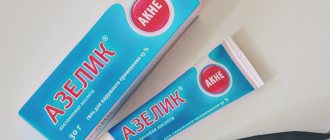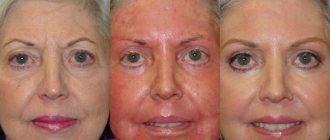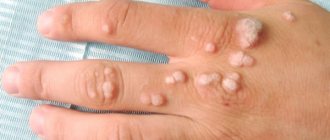People suffering from skin rashes, acne, blackheads and other skin manifestations of a similar nature are so exhausted by searching for a solution to their problem that they are ready to pay any money for an effective remedy. But often it’s enough just to look in the kitchen cabinet to find something there that, if it doesn’t solve the problem completely, will alleviate the general condition of the skin. We are talking about tea.
Briefly about types of tea
This drink can be found in every home. Most often these are black and green varieties, and those who are especially sophisticated purchase more expensive varieties: white, yellow, red, tied (dry buds of flowers blooming in a teapot). Green and black teas are familiar to most, but all varieties are collected from the same tea bush at different periods and processed differently. The green variety is more tender, its color is pale, the taste is less intense, and the aroma is subtle, sometimes barely perceptible. Its black counterpart has a richer color, tart taste, and the aroma of this drink is brighter. But it is the green variety that is more beneficial for the body, although the black variety contains all the same microelements, but in smaller quantities due to the processing method. Red varieties are the most aromatic, which is why they are often mixed in small quantities into elite collections of other varieties. But white tea is made from the youngest sprouts of the plant and is considered a drink of the elite. Peasants are skeptical about this name, calling it “warmed water.”
For dermatological problems, it is more beneficial to use green tea. It is not fermented and contains more active substances. If you don’t have this type of tea at hand, then black tea will do, but its effect will be less pronounced.
Unknown properties of familiar tea
What are the benefits of tea for the human body? Let's look at its chemical composition, which contains more than a hundred substances. Depending on the type of drink, from a third to a half of these components dissolve in water.
- Tannins. There are up to 30% of them in good tea. It is to them that the drink owes its tart taste. There are about 30 of them, but the most important of them is tannin. This substance disinfects wounds, stops bleeding, and has a bactericidal effect. For small household wounds, cuts, damage to the epidermis after acne removal, a cotton swab dipped in green tea can easily replace the green tea without burning the epidermis;
- Polyphenols. These substances are natural antioxidants. It’s not for nothing that a cup of green tea comes in handy in case of poisoning (including alcohol poisoning), viral diseases. Due to their natural origin, such antioxidants have no side effects;
- Amino acids, trace elements and vitamins. There are about twenty amino acids in tea, and among the vitamins it contains group B, ascorbic acid, P and PP, K. Mineral substances in the drink are only up to ten percent, including iron, potassium and calcium, manganese, iodine, phosphorus and others;
- Caffeine (in tea - theine). In elite varieties, the content of this substance reaches five percent, but in green drinks it is much less, and there are also completely caffeine-free types. At the same time, theine is softer than its coffee counterpart and does not accumulate in the body;
- Essential oil. There is not much of it in the drink, only a fraction of a percent, so it does not have any significant effect on the body. But thanks to him, each type of tea exudes its own unique aroma, which lifts the mood and has a beneficial effect on the nervous system;
- In addition, tea contains pigments, organic acids, pectins, proteins and carbohydrates.
It is important to understand that we are talking about high-quality brewed tea and bagged surrogate has nothing to do with this category. It is better not to consume sachets whose contents look like dust or contain added fruits, berries and herbs declared by the manufacturer. It is not clear what dyes and harmful substances are activated in boiling water.
Tips for choosing the best quality green tea
Choosing the right green tea with the highest levels of antioxidants (especially EGCG) is very difficult. Antioxidant content varies from brand to brand. You need to be careful before choosing your drink. Whether drinking or topically, choosing the right green tea is essential to reaping maximum benefits.
Here are some tips to keep in mind when choosing your brew:
- Do some research. Check the brand's label and see the amount of EGCG per serving. Browse their website and find out the EGCG levels. Choose the one that has the highest EGCG content.
- Loose leaves have a higher antioxidant content than tea bags. However, if you cannot find loose leaves, then you can choose tea bags with the highest EGCG content.
- Green tea has a shelf life of only 6 months. Make sure you choose a fresh batch of green tea. Over time, the freshness of green tea and its benefits quickly diminish.
- Look at the harvest time. The first harvest of green tea is always better than the second. The first harvest has the best quality leaves and is harvested in the first months of the year (between March and April). Always buy green tea from the first harvest.
- Choose organic green tea. This ensures that the green tea is harvested without any pesticides or other chemicals.
Green tea is good for your overall health. No matter how you use it, it can reduce acne and support your immunity. However, if you have cystic or hormonal acne, these home remedies may not work. You will need to consult with your doctor, who can prescribe specific treatments and medications.
The effects of tea on the skin
The green variety is usually used to treat dermatological problems. It contains a higher content of useful components and its beneficial effects on the skin are more obvious. This drink is used to relieve the following skin conditions:
- Acne caused by liver problems. The skin, along with sweat, removes a certain amount of toxins, therefore, with serious intoxication, it sometimes becomes covered with acne. Due to its high concentration of antioxidants, the tea can be drunk for general body cleansing and used topically to help the skin remove toxins;
- Wounds, inflamed rashes, pimples and other damage to the integrity of the epidermis. Tannins promote rapid healing. And the tannids contained in tea disinfect and destroy pyogenic bacteria. The more concentrated the decoction, the better the antimicrobial effect. Don’t rush to throw away yesterday’s tea leaves. A two to three day infusion only enhances its antibacterial properties. But you can’t drink yesterday’s tea;
- Dry skin. The microelements that make up the drink maintain the water-salt balance of the epidermis, which is especially important for dry skin or skin exposed to frostbite or active exposure to sunlight;
- Fading skin, first wrinkles. Green tea catalyzes metabolic processes, stimulating cellular metabolism and collagen production. As a result of regular external use of this product, the skin looks younger, shallow wrinkles disappear, acne marks and superficial acne scars disappear.
Green tea almost never causes allergies, except in cases of individual intolerance. Therefore, it can be used to relieve all dermatological problems: from cuts and burns to serious acne. The drink is suitable for nourishing all skin types; its effect is especially beneficial on dry skin.
How green tea helps fight acne
- Green tea has the ability to regulate sebum production. It can also inhibit sebum production by 50%.
- Green tea contains 6 active catechins - epicatechin gallate, epigallo-catechin, epicatechin, gallo-catechin, epigallo-catenin-3-gallate or EGCG, which help prevent cell damage by reducing irritation, inflammation, and also neutralize free radicals that cause acne .
- The anti-inflammatory properties of green tea help reduce swelling and redness of pimples.
- Drinking green tea regularly also helps eliminate hormonal imbalances that often cause acne.
- It can also control insulin levels as well as blood pressure, which can make acne worse.
- Green tea contains antioxidants, ascorbic acid (vitamin C), tocopherols (vitamin E), carotenoids (vitamin A), selenium, zinc, manganese and chromium. All this is important for the health of our skin.
- The antibacterial properties of green tea can kill acne-causing bacteria.
- Consuming green tea can speed up the release of the hormone serotonin, which also helps reduce stress and in turn helps avoid stress-related acne.
- Green tea protects our skin from sun damage.
- Green tea is extremely effective in unclogging pores and also improves pore size and prevents acne formation.
- Green tea also helps get rid of acne scars due to its antioxidant properties.
Tea based acne recipes
The drink can be used for rashes on the skin of the face in different ways. Lotions and compresses made from pure product, without additives, are especially convenient. But it is permissible to combine it with other herbs and add it to multi-component masks. But don't expect magical results from tea compresses and rubs. This drink is good for the most part as a prevention of acne and a means to improve the general condition of the epidermis. It is acceptable to use it as an aid in basic drug treatment.
Pure green tea decoction for acne
Having brewed the green drink firmly, leave it to brew. On the second day, its bactericidal properties will only intensify. Soak a cotton pad or cotton napkin in the tea leaves and apply to the skin as a compress. You can use the decoction to wipe acne-affected areas, wash your face, completely replacing clean water with it, or make cosmetic ice from it. Such procedures will disinfect the skin, destroy pathogenic bacteria, serving as a means of preventing the occurrence of pimples, blackheads and other rashes.
Chamomile+mint+green tea against rashes on the face
In the same way, it is permissible to use herbal tea to get rid of acne forever. Take equal amounts of green tea, chamomile and peppermint. All you need to do is leave this decoction for an hour and begin the procedures.
Black tea lotion with lemon against wrinkles, scars and acne marks
But black tea works better with scars, small wrinkles and scars after acne removal. Adding lemon to it helps lighten red or blue areas. All housewives are accustomed to preparing the product: brew a strong black drink, add a few slices of lemon (you can grate it), and let it sit. We store this lotion in the refrigerator for no longer than a week. Citrus fruits are a strong allergen, therefore, if you detect any skin reactions to the resulting product, replace the lemon with mineral water or simply wipe your skin with pure black tea.
Mask for cleansing pores and nourishing problematic skin
To cleanse your face and body weekly of excess sebum, which causes blackheads, you can use a delicious mask of oatmeal with honey and black tea. Mix the components in arbitrary proportions, bringing to a convenient consistency. If you are not allergic to honey, then this product is completely harmless and can be in direct contact with the skin for half an hour. It is good to use it after a steam bath and physical removal of blackheads.
Nourishing mask for all skin types with tea
Any tea that you are used to drinking is suitable for this remedy. Add the egg yolk to a strong tea brew and add flour to the resulting cocktail to give it a consistency that can adhere to the skin on its own without spreading. This mask is left on the face for 20 minutes to nourish and tone.
External tea-based remedies against acne and other skin manifestations have no contraindications and are therefore used for all skin types. Allergic reactions occur to individual components of multi-component masks and decoctions. All products are applied to clean skin.
Does green tea help with acne?
Yes, green tea can help you deal with acne vulgaris due to the following benefits:
Helps reduce inflammation
Green tea is rich in catechins. Of the four main catechins found in green tea, epigallocatechin-3-gallate (EGCG) has been shown to be beneficial in the treatment of acne and rosacea. It works by reducing inflammation. A study found that applying 2% green tea lotion reduced inflammatory acne.
EGCG is a powerful antioxidant and has immunomodulatory and photoprotective properties. It also has antiangiogenic (meaning it reduces the growth of new blood vessels that tumors need to grow) and anti-inflammatory effects.
It helps reduce sebum production
Excessive sebum production is one of the main causes of acne. Topical application of green tea can help reduce sebum secretion and treat acne.
A study of 22 non-smoking healthy men examined the effects of 5% topical green tea extract for 60 days. Researchers found a significant decrease in sebum secretion.
Drinking green tea can also help reduce sebum production and fight acne.
Polyphenols in green tea help reduce acne
Green tea polyphenols are powerful antioxidants. A clinical study examined the effects of 2% tea lotion on 47 patients with mild to moderate acne. After two weeks, the researchers observed a therapeutic effect on acne lesions.
Helps reduce acne-causing bacteria
An 8-week study found that EGCG, one of the four main catechins in green tea, may help reduce acne by inhibiting the growth of P. acnes bacteria.
These studies are not conclusive and further research is needed to evaluate the effectiveness and benefits of green tea for acne. Also, note that green tea or any other home remedy may not work on cystic and hormonal acne. You need to consult your doctor for proper treatment.
However, if you have mild to moderate acne, you can try using (or consuming) green tea at home to help manage your condition. Here are some recipes you can try at home.
How to drink and prepare tea correctly
Masks and other acne remedies described above are applied topically. They have a clear but short-term effect. For more lasting results and overall improved health, it is better to take tea in the traditional way - drink and enjoy the process. The skin is a mirror of the internal state of the body, therefore all rashes on it are the result of general ill health. According to scientific studies, among people who regularly drink tea, the incidence of cancer is 30% lower. And those who are accustomed to drinking a cup of tea before starting work work more productively and get sick less often. To lift your tone and mood, strengthen your immune system, speed up metabolic processes, restore water-salt balance and simply enjoy the aroma, it is important to prepare and consume tea correctly.
- Yesterday's drink is good for cosmetic procedures. You can only drink today's tea;
- Do not use the product on an empty stomach;
- If after the next cup you feel an increased heartbeat or other changes in the cardiovascular system, then it is better to refuse the next one;
- Brew the mixture no more than three to four times;
- The ready-to-drink drink should be warm. Cold or hot will not do any good.
It is especially important to mention monastery tea against acne. Monastery teas are available for literally all ailments: alcoholism, varicose veins, liver and heart diseases, to improve brain activity, digestion and sleep. This is a special collection that you can buy ready-made or prepare yourself at home. All components for the recipe are easy to get at pharmacies and stores:
- Herbs: St. John's wort, oregano, elecampane;
- Fruits: rose hips, lemon;
- Base: black tea.
A decoction is prepared from the herbs, to which honey and lemon are added for taste. Take a glass of acne medication twice a day, do not tie it to meals. The course of treatment is 4 weeks. To believe or not to believe the healing properties of the collection is an individual decision. Analyzing the composition, we can conclude that such a remedy is aimed at general cleansing of the body. Herbs have good bile and diuretic properties, improve digestion, increase sweating and strengthen the immune system. All these properties together have a beneficial effect on the body, cleanse the liver and normalize the functioning of the gastrointestinal tract, which has a positive effect on the quality of the skin.
Drinking tea is important to enjoy. This drink is not addictive and does not have a negative effect on organs and tissues. But as with any other product, you need to observe moderation and avoid drinking tea during periods of emotional excitement and stress.
Reviews on the use of tea against acne
“When I was a child, my mother rubbed my eyes with gauze soaked in strong tea. Only as I got older did I wonder what the connection was between tea and sour eyes. During my studies at the institute, when I had to get little sleep at night, the same gauze with tea saved me from dark circles under my eyes. Then lotions with this drink were applied to the entire face to help get rid of acne. And the tea coped with all the tasks assigned to it.”
Alena, 32 years old
“In Crimea last year we visited a monastery near Bakhchisarai. There I bought honey and teas from the monks. Among them, I took tea for my son against acne. He resisted and categorically refused to drink. If there had been some brand on the packaging, things would have been more fun, but otherwise we had to fight. After a couple of weeks, the effect was already noticeable. And by the end of the course, my face and body were practically cleared. Now there is a break in the appointment, the son is silent (you won’t get any thanks), but he won’t refuse the next course.”
Anastasia, 42 years old
“I once succumbed to fashion trends and became interested in the culture of the East. The tea ceremony has been studied inside and out. I have read, watched and tried a lot about the properties of tea. Both green and black teas are drunk, rubbed and spread in my family. My skin problems are gone forever, so I recommend this drink to everyone.”
Zhanna, 24









